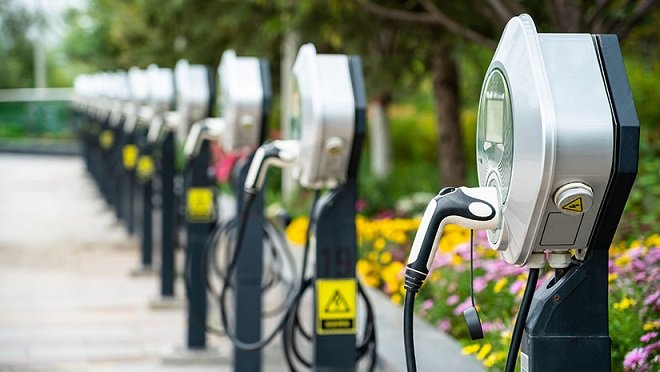Key Takeaways:
- DC fast charging stations are essential for widely adopting electric vehicles (EVs).
- The improvement in charging technology could significantly reduce charging times.
- As EVs become more common, charging infrastructure must expand accordingly.
The Growth of Electric Vehicles
The rise in popularity of electric vehicles (EVs) is certainly changing the transportation scene. A combination of environmental aspirations and technological advances is driving this change. Governments are setting ambitious targets for lowering carbon emissions globally, and EVs are pivotal in these plans. Many people are opting for cleaner alternatives to traditional internal combustion engine vehicles due to their significant role in urban pollution. The International Energy Agency predicts that there will be 145 million electric cars on the streets by 2030, showing significant growth compared to previous years. This shift is a testament to the increasing environmental awareness resulting from technological evolutions making EVs more affordable and efficient.
The Importance of Charging Infrastructure
Robust charging infrastructure is essential for electric vehicle adoption to continue its upward trajectory. Think of it this way: owning an EV without accessible charging points is like having a smartphone without access to any power outlets. As more drivers invest in EVs, the demand for charging solutions increases exponentially. This is why expanding the charging network is paramount for accommodating future growth. Cities like Amsterdam and Oslo have successfully rolled out extensive networks of chargers, serving as blueprints for global implementation. These charging networks ensure seamless travel for EV owners, reducing range anxiety and encouraging further adoption. The introduction of the DC fast charger exemplifies innovations in charging technology necessary to cater to this increasing demand.
Understanding DC Fast Charging
DC fast charging completely transforms the electric mobility industry. Although they are effective, traditional charging methods for EVs typically take several hours to fully charge, making them inconvenient for long trips or people with busy schedules. Nevertheless, electric vehicles can be charged up to 80% in just 20 to 30 minutes at DC fast charging stations. These chargers minimize downtime by providing high power output directly to the battery, making EVs a viable option for more consumers. Innovations in battery technology, such as those highlighted in various automotive news platforms, are enhancing the efficiency and speed of these chargers, addressing one of the most significant barriers to EV adoption—charging time.
Challenges and Opportunities in Implementing DC Fast Chargers
The implementation of DC fast chargers is challenging. One of the primary hurdles is the cost of installing these high-tech charging stations. Furthermore, the strategic placement of these individual units is crucial to maximize their utility and accessibility. Integrating them into existing infrastructure without causing inconvenience requires extensive planning and investment. However, where challenges exist, so do opportunities. Companies and governments that successfully expand and optimize charging networks stand to gain significantly, not only in profits but also in contributing to a sustainable future. As traditional fuel stations gradually shift to support electric charging, the potential for job creation and technological development increases, making this sector ripe for innovative solutions.
The Role of Policy and Incentives
Policy plays a critical role in the advancement of electric vehicle infrastructure. Governments can expedite the transition from gasoline-dependent transportation systems by setting clear guidelines and standards for EV charging. Incentives, such as tax breaks and subsidies for businesses that install charging stations, have proven effective in many regions. For example, in California, these rewards have resulted in a notable rise in public charging stations. These initiatives are essential in encouraging private investment and ensuring EV infrastructure keeps pace with vehicle adoption rates. The insights from green policy resources underscore how legislative frameworks can directly influence and bolster the growth of electric vehicle ecosystems.
User Experience and Accessibility
The success of DC fast-charging networks is heavily reliant on user experience. The convenience of location and ease of use can significantly impact an EV owner’s willingness to rely on public charging stations. Chargers that are easy to locate, use intuitive interfaces, and are placed in high-traffic, convenient locations are more likely to be utilized frequently. This is especially important in urban areas with limited space and high competition for real estate. Efforts should be directed towards making chargers as accessible as possible, which will help build consumer confidence in using electric vehicles for daily commutes and long journeys. In addition, implementing transparent pricing models and integrating user-friendly payment systems can further enhance the overall charging experience. As infrastructure develops, these elements will be crucial in attracting and retaining satisfied EV customers.
Industry Collaboration and Innovation
The advancement in charging technology requires concerted efforts from various industry stakeholders. Collaboration between automotive companies, energy providers, and technology innovators fosters an environment where breakthroughs can rapidly occur. Many companies are forming partnerships to develop universal charging standards, streamline infrastructure deployment, and enhance technological capabilities. Such collaborative efforts are essential in overcoming the barriers to widespread DC fast-charging adoption, from technical challenges to infrastructure costs. Continued research and development will undoubtedly yield improvements that bring us closer to an electrified future. Moreover, sharing insights and data across sectors can lead to novel solutions that address current limitations and optimize the performance and reliability of charging networks.
The Future of Electric Transportation
The future of electric transportation is promising, with ongoing advancements poised to redefine the norms of vehicle usage. The continuous improvement of fast charging solutions stands to significantly influence consumer behavior, reducing one of the main barriers to EV adoption—charging time. As technology progresses, we can anticipate even faster charging times, increased battery capacities, and broader network coverage. This evolution benefits EV owners by improving convenience and supports global sustainability efforts. Increasing the number of DC fast chargers is essential in achieving global climate targets and promoting a more environmentally friendly future for everyone. Additionally, the incorporation of sustainable energy sources into charging infrastructure will enhance environmental advantages, support overall green energy goals and revolutionize the sustainable transportation sector.




